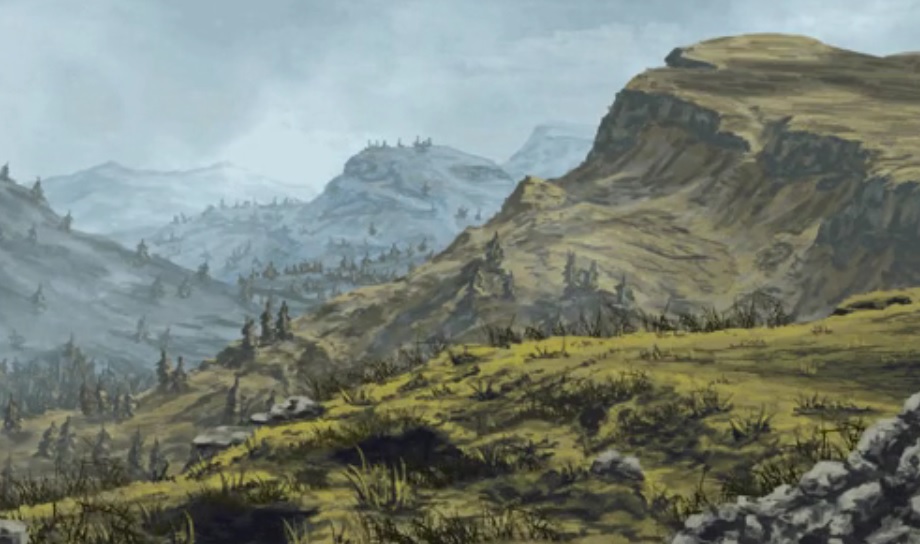Difference between revisions of "Random Wilderness Generator (RWG)"
Tao alexis (talk | contribs) |
Tao alexis (talk | contribs) |
||
| Line 15: | Line 15: | ||
| — || 0 || align="left"|sea || align="left"|coastline passes through two points on the hex. | | — || 0 || align="left"|sea || align="left"|coastline passes through two points on the hex. | ||
|- | |- | ||
| − | | 01-02 || | + | | 01-02 || 50 || align="left"|flat || align="left"|level, lacking undulations or slopes, with slow water drainage. |
| + | |- | ||
| + | | 03-08 || 100 || align="left"|rolling hills || align="left"|gentle to moderate, with occasional variations in elevation. | ||
| + | |- | ||
| + | | 09-32 || 200 || align="left"|undulating hills || align="left"|moderate to high slopes, with notable changes and gulleys. | ||
| + | |- | ||
| + | | 33-70 || 400 || align="left"|foothills || align="left"|significant dips and rises, with irregular steep slopes and low stretches. | ||
| + | |- | ||
| + | | 71-85 || 800 || align="left"|rugged hills || align="left"|commonly steep throughout, with rock outcrops, narrow valleys and uneven level areas. | ||
| + | |- | ||
| + | | 86-94 || 1500 || align="left"|round mts || align="left"|abrupt slopes and bluffs, with rounded peaks, rocky ridges and ravines. | ||
| + | |- | ||
| + | | 95-98 || 3000 || align="left"|mountains || align="left"|dramatic rocky ledges, with rugged cliffs, canyons and sparse vegetation. | ||
| + | |- | ||
| + | | 99 || 4500 || align="left"|craggy peaks || align="left"|precipitous climbs, jagged peaks, rock faces, deep gorges, absence of vegetation. | ||
| + | |- | ||
| + | | 00 || 6000 || align="left"|alpen || align="left"|sharp ridges, sheer rock faces, glaciers and snowfields, constant winds. | ||
|} | |} | ||
Revision as of 03:34, 14 June 2024
The Random Wilderness Generator is a tool designed for use during gameplay when the dungeon master needs an outdoor starting point for an unprepared setting or wants to introduce randomness into the game party's environment. It's intended to be an useful resource for solo play and for training oneself as a DM. When using this generator, the initial location of the player characters is always in an area where no habitation or infrastructure is present, an unknown distance from civilisation. The nature of starting hex depends upon the steepness of terrain, the local hydrography, the local vegetation and the climate type. From these details, the degree of threat to the players is determined, as well as the resources which they may put to use, permitting them opportunities to become informed about the world they're in.
Contents
Because the wilderness is a much more complicated arena than the limited passages and chambers of an underground dungeon, we should not look to simplified die rolls in order to achieve even the bare whiff of similitude, which must be the goal here. On the other hand, while a functionally real world setting might be created with a highly complex computer generated approach, we'd be at the mercy of that system once it was made, without the ability to spontaneously add results, shift the balance of results, or see directly the step-by-step process of the world being made before us. This may require the consulting of several tables to produce an answer, but as this generator isn't intended to be used during game play, we have the time to study and adapt ourselves to the system as we see the setting unfold.
Links to this page, and throughout this wiki to other dungeon generation pages, include the "RWG" designation and will be categorized under "Random World."
Terrain
Because the relative lay of the land affects so many other things: the placement of rivers and lakes, the presence of vegetation and the nature of creatures that exist there, as well the practicality of settlement and land use, we must begin with the terrain's relief — the heights and depths of the landforms present, relative both to sea level and to other forms within the same unit of area. For our purposes, this is a hex that's 6⅔ miles in diameter, with an area of approximately 38 square miles.
| Roll | variation (ft.) | type | description |
|---|---|---|---|
| — | 0 | sea | coastline passes through two points on the hex. |
| 01-02 | 50 | flat | level, lacking undulations or slopes, with slow water drainage. |
| 03-08 | 100 | rolling hills | gentle to moderate, with occasional variations in elevation. |
| 09-32 | 200 | undulating hills | moderate to high slopes, with notable changes and gulleys. |
| 33-70 | 400 | foothills | significant dips and rises, with irregular steep slopes and low stretches. |
| 71-85 | 800 | rugged hills | commonly steep throughout, with rock outcrops, narrow valleys and uneven level areas. |
| 86-94 | 1500 | round mts | abrupt slopes and bluffs, with rounded peaks, rocky ridges and ravines. |
| 95-98 | 3000 | mountains | dramatic rocky ledges, with rugged cliffs, canyons and sparse vegetation. |
| 99 | 4500 | craggy peaks | precipitous climbs, jagged peaks, rock faces, deep gorges, absence of vegetation. |
| 00 | 6000 | alpen | sharp ridges, sheer rock faces, glaciers and snowfields, constant winds. |
